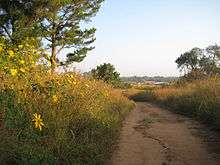Mwinilunga

Mwinilunga is a town in the North-Western Province of Zambia and headquarters of a district of that name. It lies on the West Lunga River, not far from the borders with the Democratic Republic of the Congo and Angola.
Overview
The town had a population estimated at 14,500 in 2006. The Chilunda-speaking Kanongesha-Lunda people are the largest ethnic group, and are related to the Chibemba-speaking Kazembe-Lunda of Luapula Province.
The town's elevation is 1387 m and it is one of the wettest places in Zambia with annual rainfall of about 1400 mm falling in the rainy season from October to May. The town is also home to a small airport.
Climate
| Climate data for Mwinilunga | |||||||||||||
|---|---|---|---|---|---|---|---|---|---|---|---|---|---|
| Month | Jan | Feb | Mar | Apr | May | Jun | Jul | Aug | Sep | Oct | Nov | Dec | Year |
| Record high °C (°F) | 33.1 (91.6) |
31.9 (89.4) |
31.0 (87.8) |
30.6 (87.1) |
30.8 (87.4) |
30.2 (86.4) |
31.4 (88.5) |
32.8 (91) |
36.8 (98.2) |
34.8 (94.6) |
33.6 (92.5) |
31.7 (89.1) |
36.8 (98.2) |
| Average high °C (°F) | 26.0 (78.8) |
26.3 (79.3) |
26.8 (80.2) |
27.3 (81.1) |
27.0 (80.6) |
25.9 (78.6) |
26.3 (79.3) |
28.7 (83.7) |
31.0 (87.8) |
29.9 (85.8) |
27.4 (81.3) |
26.2 (79.2) |
27.4 (81.3) |
| Daily mean °C (°F) | 19.9 (67.8) |
19.9 (67.8) |
20.1 (68.2) |
19.9 (67.8) |
18.2 (64.8) |
15.9 (60.6) |
16.1 (61) |
18.9 (66) |
21.7 (71.1) |
21.3 (70.3) |
20.3 (68.5) |
19.8 (67.6) |
19.3 (66.7) |
| Average low °C (°F) | 16.2 (61.2) |
16.2 (61.2) |
16.0 (60.8) |
14.2 (57.6) |
10.1 (50.2) |
6.7 (44.1) |
6.6 (43.9) |
9.3 (48.7) |
12.4 (54.3) |
14.8 (58.6) |
15.8 (60.4) |
16.2 (61.2) |
12.9 (55.2) |
| Record low °C (°F) | 11.6 (52.9) |
12.6 (54.7) |
10.0 (50) |
7.8 (46) |
1.6 (34.9) |
−1.9 (28.6) |
0.5 (32.9) |
0.9 (33.6) |
1.6 (34.9) |
8.1 (46.6) |
10.5 (50.9) |
7.3 (45.1) |
−1.9 (28.6) |
| Average precipitation mm (inches) | 241.8 (9.52) |
200.4 (7.89) |
266.7 (10.5) |
89.5 (3.524) |
12.1 (0.476) |
1.3 (0.051) |
0.0 (0) |
3.2 (0.126) |
18.5 (0.728) |
91.7 (3.61) |
222.0 (8.74) |
265.9 (10.469) |
1,413.1 (55.634) |
| Average precipitation days (≥ 1.0 mm) | 24 | 21 | 23 | 11 | 1 | 0 | 0 | 0 | 2 | 12 | 21 | 25 | 140 |
| Average relative humidity (%) | 82.5 | 84.6 | 84.1 | 77.6 | 70.2 | 64.5 | 58.7 | 50.8 | 49.1 | 67.8 | 78.3 | 83.7 | 71.0 |
| Mean monthly sunshine hours | 136.4 | 120.4 | 151.9 | 228.0 | 294.5 | 297.0 | 310.0 | 297.6 | 261.0 | 213.9 | 156.0 | 133.3 | 2,600 |
| Source: NOAA[1] | |||||||||||||
Schools
Mwinilunga Secondary School is the largest school to date in town. Government and Community Schools pepper the rural area surrounding the boma and provide education for children grades 1 to 12.
Industry
Attempts have been made to establish industries in the town such as the TIKA Iron and Steel plant and the pineapple cannery. Neither were commercially successful and have closed due to the distance of the town from the markets of the Copperbelt and the lack of a railway and source of coking coal for the TIKA plant.[2]
In 2006 plans were formulated to extend the proposed railway to Solwezi to the town and even on to the Benguela Railway in Angola to avoid reliance on the line in the DR Congo, but these plans have not been confirmed and the Benguela Railway has not yet been re-opened. However, the Angolan transport ministry plans to build a line branching off the Benguela Railway at Luacano and entering Zambia from Macango.[3]
Mwinilungu ought to benefit from trade with Angola and DR Congo (which both have considerable Lunda populations too) but wars, poor road conditions and various trade policies between the countries have so far prevented trade developing.
Forest Fruits Ltd. has been operating in Mwinilunga since 1997, successfully working with over 5000 beekeepers in the region to export organic honey to the European market.
There is much work investigating the possibility of nearby copper and uranium deposits. Such mines already exist in various location along the highway between Solwezi and Mwinilunga.
Tourism
The annual Chisemwa cha Lunda ceremony held by Senior Chief Kanongesha of the Lunda draws crowds to the district every September.[4]
Mwinilunga lies south east of the rainforest Nchila Wildlife Reserve, known for its sable antelope and other large mammals, Luakela Forest Reserve and the Chitunta Plain, known for its birdlife and as the source of the Zambezi River.

References
- ↑ "Mwinilunga MET Climate Normals 1961–1990". National Oceanic and Atmospheric Administration. Retrieved April 5, 2015.
- ↑ Times of Zambia website: Julius Kaoma: "Why steel, iron are key to national development", accessed 1 March 2007.
- ↑ Lourenço, Manuel João (20 June 2011). "Projecto de reabilitação e modernização dos caminhos de ferro de Angola" [Project to rehabilitate and modernize the Angolan railways] (in Portuguese). Instituto Nacional dos Caminhos de Ferro de Angola (INCFA)/Angolan transport ministry.
- ↑ Times of Zambia website accessed 1 March 2007
Coordinates: 11°45′30″S 24°25′45″E / 11.75833°S 24.42917°E